SEE LABOR & TIME SAVINGS THROUGH FOOD WASTE MANAGEMENT WITH A FOOD WASTE DISPOSAL SYSTEM
While no one enjoys thinking about their trash, managing waste effectively is crucial for the smooth operation of any food service business. A commercial food waste disposer can significantly enhance the efficiency of your kitchen. Growing up, my older brother once explained to me how upgrading a car engine works, and I’ve realized this principle applies to various systems, including kitchens. Essentially, he said that increasing power is the first step, but after a certain point, improving the exhaust system becomes essential. For car enthusiasts, this might answer the question of why headers are added to engines. The idea is to ensure that waste or output is removed at a pace that matches the input, keeping the system running efficiently.
A commercial kitchen functions similarly. As the number of customers increases, so does the volume of food waste that needs to be handled. Whether it’s a hotel, hospital, school cafeteria, or college dining hall, there will always be leftover food and dirty dishes that require disposal. Typically, there's a scraping station before the dishwasher. By using a commercial food waste disposer, such as the Insinkerator SS-100 Disposer or the Salvajor 100 Commercial Disposer, you can streamline this process and reduce the amount of solid waste you need to dispose of. These disposers offer an economical way to cut down on food waste and save both time and labor.
How Do Commercial Disposers Work?
Most disposers connect directly to the sewage system. When dishes are rinsed, food remnants are directed into the disposer, where they are ground up and flushed away through the drain. Some disposers reduce food waste significantly by grinding it and storing the dried waste in a removable container, which can later be composted and used to enrich soil. Throughout the process, these disposers decrease the mass and volume of food waste by breaking it down and using water.
Types of Commercial Food Waste Disposers
1. Disposer with Sink - This is a complete unit designed for commercial kitchens. It includes a large sink, disposal, and a console to operate the system. A commercial faucet must be added, and the unit needs to be connected to the sewage line. Many food waste collectors recycle the water used to break down waste, helping to conserve water during the process.
2. Disposer Without Sink - These disposers resemble home models but are larger and more powerful. They need to be installed under a sink in your kitchen and should match the sink bowl brand. Adapters are available to ensure proper connection between the disposer and the sink.
3. Disposer With Collection Bin - This type grinds food waste in water and then separates the waste and water in a dewatering system. The "gray water" is flushed into the sewage line, while the dry, ground-up food waste is collected in a bin or tray for removal. This system is ideal for businesses with sustainability goals, as the compostable waste can be reused as fertilizer.
What Types of Food Waste Should Go Into a Disposer?
Although adding a disposer simplifies dishwashing, not all food waste belongs in one. Ideal for organic and biodegradable materials, disposers are great for fruit and vegetable scraps, meat, poultry, bread, grains, bones, seafood, and trimmings. However, fibrous foods like artichokes, pineapple tops, and corn husks should be avoided. Oyster and clam shells should also be disposed of separately. Non-food items like wrappers, napkins, plastics, and utensils should never go into a disposer, nor should grease, oil, or solid fats, which can clog the plumbing. To prevent unwanted items from entering the disposer, it’s helpful to place a trash can nearby.
Benefits and Challenges of Food Waste Disposal Systems
These disposers save time and labor by making cleanup easier and faster. They also reduce garbage waste, saving you money on waste removal and freeing up valuable kitchen space. Moreover, they keep food waste out of landfills and can provide compostable material for gardening. However, investing in a quality disposer requires maintenance and proper training for staff to ensure safe and effective use.
Before choosing a disposer, consult with an expert at Cook’s to find the right brand and model for your needs. Ensure the model selected has sufficient horsepower for your operation’s volume. We can also help with installation and placement to optimize workflow in your dishwashing area.

Keywords:
Vacuum casting iron plate,Three-pedal upright piano,Pure Copper Hardware Upright Piano
Masonhanlin Musicalinstrument Co. LTD, , https://www.meiseninstrument.com




